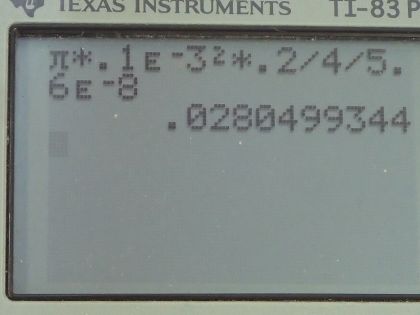Question
If the 0.100-mm diameter tungsten filament in a light bulb is to have a resistance of at , how long should it be?
Final Answer
Solution video
OpenStax College Physics for AP® Courses, Chapter 20, Problem 26 (Problems & Exercises)

vote with a rating of
votes with an average rating of
.
Calculator Screenshots
Video Transcript
This is College Physics Answers with Shaun Dychko. Knowing that a piece of tungsten wire has to have a resistance of 0.200 ohms and it has a diameter of 0.100 millimeters, which we write in meters because we also want to change our units to mks type units at the beginning of a question just so that we don't have to worry about this unit conversion later on so mks is meters, kilograms and seconds. And then we need to look up the resistivity of tungsten which is in table [20.1] and tungsten is 5.6 times 10 to the minus 8 ohm meters of resistivity and we can rearrange this formula to figure out how long this tungsten filament in the light bulb can be. So resistance is resistivity times the length of a wire divided by its cross-sectional area and so we are solving for L by multiplying both sides by area divided by resistivity and so the length then is the area times the resistance divided by resistivity. Now area is π times radius squared— this is a cross-sectional area of a cylindrical wire— and so its area is going to be π times its radius squared here and we are not given the radius though we are given the diameter so we divide the diameter by 2 and substitute that in place of r and so the area then is π times diameter squared over 4. So we replace area with πd squared over 4 and then clean it up a little bit by putting the 4 in the denominator and we have a formula for the length then π times diameter squared times resistance divided by 4 times the resistivity of this particular material which is tungsten. So we have π times 0.100 meters times 10 to the minus 3 squared multiplied by 0.200 ohms of resistance divided by 4 times 5.6 times 10 to the minus 8 ohm meters of resistivity for tungsten and this works out to 2.80 centimeters should be the length of this tungsten filament.
